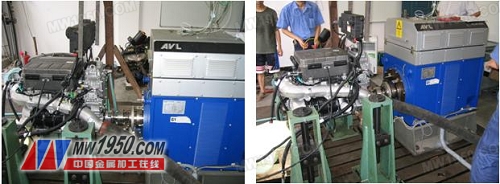Application Research on Key Technology of Assembly and Testing of a High Speed ​​Aluminum Alloy Engine (6)

Engine running-in test bench
(1) Engine running-in and test
After the engine is assembled, it should be run-in and tested. The purpose is to improve the surface quality of the mating parts so that they can withstand the required load. It is also the premise to judge the durability test of the engine assembly test quality. 1. Reduce the amount of wear in the initial stage, extend the service life of the engine; inspect and eliminate defects in the assembly; adjust the mechanisms to coordinate with each other for good power and economy. The test run of the engine, including cold grinding test and hot test run, as shown in Figure 3 is the engine running-in diagram. Engine running-in includes cold running-in and heat-running. Due to the improvement of the manufacturing process level, the existing engine development has gradually eliminated the cold running-in. The following focuses on the thermal run-in.
When the heat is running, the idle running time should not be too long. In principle, do not exceed 15 minutes. Otherwise, the combustion is not enough. The excessive carbon deposition is very unfavorable for the valve, piston and steel sleeve. Perform heat on the dynamometer with load for more than 20 hours, grind the cylinder and check the reliability of the engine parts and electrical parts. The thermal running-in procedure for the development period should be improved in actual operation. In the running-in test, after the first run-in for 6 to 10 minutes, the oil should be replaced and the running-in is performed.
1 No-load hot test of the engine: The hot test usually performs no-load test on the gantry. Through the hot test, it is further checked whether the repair and assembly work meets the requirements, the parts are further lapped, and the necessary adjustments are made to the engine. The engine hot test specification is: first test for 30min at 1500-2000r/min, then test for 30min with 2000-3000r/min, and test for 30min at 3000-6000r/min. During the hot test, the engine water temperature should be maintained between 75-90 °C, and the oil temperature should not be higher than 80 °C.
Adjust the ignition timing and idle speed to make the engine run smoothly. Check the gasket, oil seal, water seal and oil pipe joints of each part. If there is oil leakage, water leakage or air leakage, it should be removed in time. Check that the oil pressure gauge and water temperature gauge are reading properly. Check that each cylinder is working well and that there is an abnormal sound inside the engine. Check engine cylinder pressure after hot test. Check the cylinder pressure should be carried out when the engine water temperature is normal, remove all the spark plugs, start the engine to rotate the engine, check the cylinder pressure gauge by cylinder, the cylinder pressure should meet the requirements.
Previous Next
A Sanitary Pressure Relief Valves is a type of self-acting device, designed for keeping tanks work properly. It can release air out of the tanks to maintain pressue, and also absorb air into tanks to be anti-vacuum. Sanitary Pressure Relief Valves including stainless steel sanitary pressure relief valves, food grade pressure relief valves, hygienic pressure relief valves, vacuum relief valves, air release valves. Kaysen Steel is a china manufaturer and supplier of stainless steel sanitary pressure relief valves, food grade pressure relief valves, hygienic pressure relief valves, vacuum relief valves, air release valves, we supply supperial quality stainless steel sanitary pressure relief valves,vacuum relief valves, air release valves in SS304, SS316, SS316L materials, size from 1/2"-4", DN15-DN100, connection types contains weld, clamp, thread types,etc
Sanitary Pressure Relief Valves Specification:
Material: SS304, SS316 or SS316L
Connection Standard: 3A, DIN, SMS, ISO, IDF
Port size: DN20-DN50, 3/4"-2"
Connection type: weld, clamp, thread
Gasket material: EPDM, FPM.
Pressure: 0.5-2bar, Vacuum:0.3-0.9bar
Temperature range: -10℃ to 120℃(EPDM)
Sanitary Safety Valves,Food Grade Safety Valves,Hygienic Safety Valves
Kaysen Steel Industry Co., Ltd. , https://www.chinasanitaryvalve.com